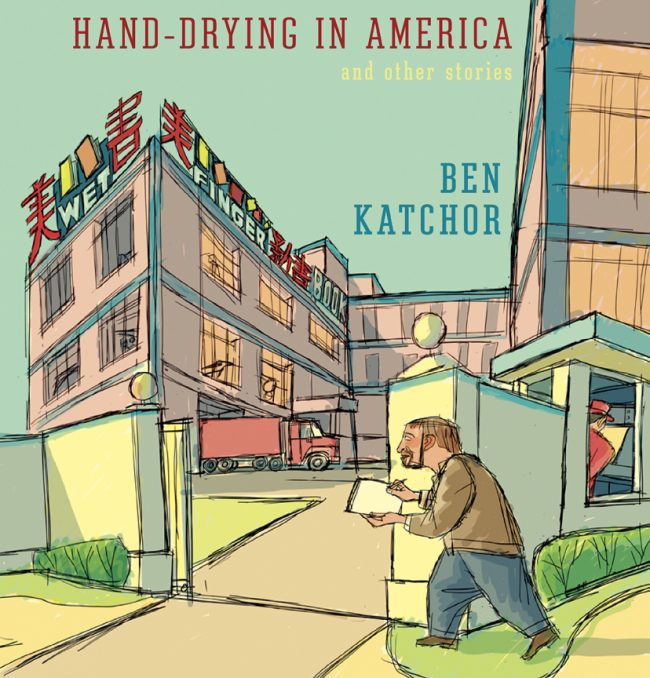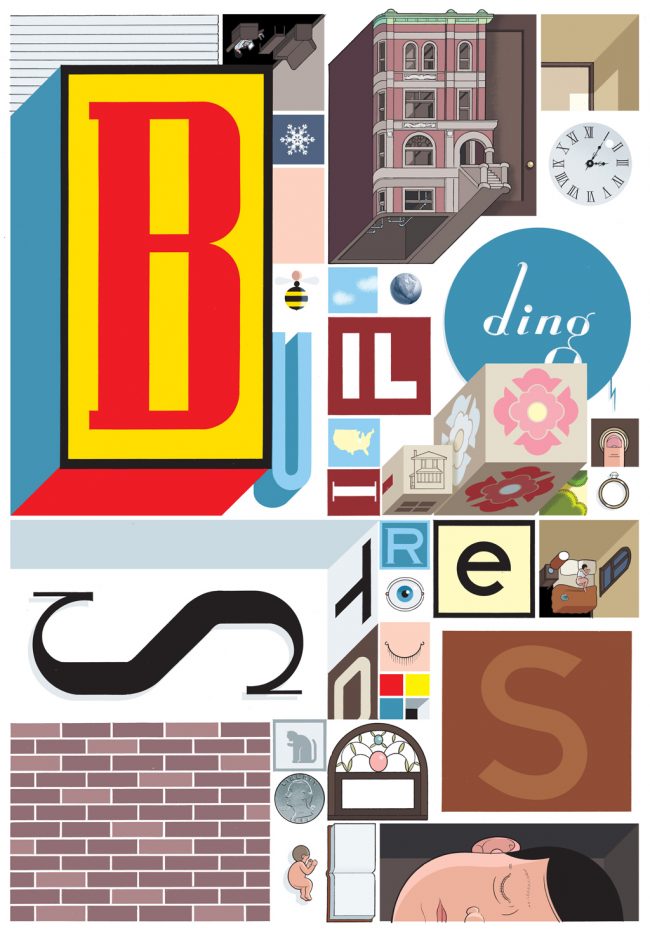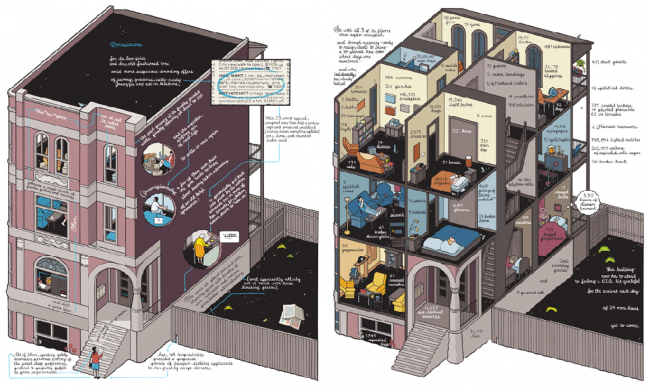
We are celebrating 15 years — and counting — of stories that are deeply researched and deeply felt, that build a historical record of what the city has been.
We are celebrating 15 years — and counting — of stories that are deeply researched and deeply felt, that build a historical record of what the city has been.
Architecture and urban planning rely heavily on visual representation. While a written description of a building or reading of the zoning code may provide some sense of their effect, the ability to envision a proposed, future reality often requires maps, diagrams, drawings, and renderings. These tools are by no means neutral, but their subjectivity does not negate their utility. It was with these tools in mind that I was drawn into a subset of verbal and visual storytelling with which I was previously unfamiliar: graphic narratives and novels or, as they’re more commonly called, cartoons.
 Two particular works brought me there: Hand-Drying in America by Ben Katchor, a MacArthur and Guggenheim fellow and author of the cult comic strip Julius Knipl, Real Estate Photographer, and Building Stories by Chris Ware, the recipient of more Harvey, Eisner, and Ignatz awards than anyone else in comics history. Katchor’s book is an anthology of one-page vignettes skewering the fields of architecture, urban planning, and product design while Ware’s is a box of 14 distinct pamphlets, papers, and books documenting the lives of the occupants of one Chicago walk-up.
Two particular works brought me there: Hand-Drying in America by Ben Katchor, a MacArthur and Guggenheim fellow and author of the cult comic strip Julius Knipl, Real Estate Photographer, and Building Stories by Chris Ware, the recipient of more Harvey, Eisner, and Ignatz awards than anyone else in comics history. Katchor’s book is an anthology of one-page vignettes skewering the fields of architecture, urban planning, and product design while Ware’s is a box of 14 distinct pamphlets, papers, and books documenting the lives of the occupants of one Chicago walk-up.
Hand-Drying in America is the more lighthearted of the two, or rather, the one that guilds its cynicism and critique with wit and humor. Each strip, in essence, extends contemporary trends to illogical extremes as a form of criticism. He takes both “progressive architects” and ardent preservationists to task in “The False Step,” proposing that the cracks and bumps you trip over should be preserved in our buildings and streets for their memory-creating possibilities, and furthermore, that they should be incorporated into new designs to create an elevated “aesthetic experience.” In one strip that called to mind the growing notoriety of micro-apartments, “Under the Bed” tackles the efficient use of space, chronicling a proposal of one designer to turn the “terra incognita” of the space under beds, “an area equal to one-third of the Earth’s surface,” into a usable space complete with recessed lighting. “A Look at the Poleax Building” laments the drive to privatize public goods as a corporate tower’s guards shake down pedestrians for a $1.25, a fee for having looked at the building, while executives look out at the harbor from above, free of charge. And in a personal favorite, Katchor speaks to the plague of developments that turn only a long blank wall to the streets around them, not only deadening street life but in his imagination, killing two wayward tourists in “Behind Sty Center.”
Katchor’s indictments are often worthy of a hearty, genuine laugh, but they also hit their critical mark. He chronicles the annoyances and ridiculous aspects of urban life, and often quite masterfully implicates the reader (in this case, me) in the process, whether it’s the walker distracted by a cellphone or the urban explorer overly enamored with outdated infrastructure. His ability to make this reader laugh, at the strips and at my own habits or beliefs, makes this a worthy read for anyone with an interest in the design of the built environment — or really anyone living in a city. In addition to providing an alternate world in which some of our less desirable tendencies and ideas are allowed to grow to their quite absurd conclusions, Hand-Drying in America reminds us that the seemingly trivial can be rather important and what we consider important can often be ephemeral. I suggest reading one or two at a time over the course of a month or two – reading it straight through, as I did, may lead to a bit too much self-realization.
 Building Stories does not provoke the same laughter. Ware’s wide-ranging history is often tragic and almost uniformly heart-wrenching, though its unique and careful construction make it well worth the read. The New York Times Book Review agrees, naming Building Stories one of the top 10 books of 2012. Ware uses architectural drawing techniques, namely axonometric projections and section cuts, to satisfy a voyeuristic urge to see the people and relationships just behind a building’s façade and to depict simultaneous events occurring throughout the building. These moments both acknowledge the hints of our neighbor’s home lives that we gather through the sounds and chance meetings born of high-density living and display the diversity of experiences that can happen in one, albeit subdivided, space.
Building Stories does not provoke the same laughter. Ware’s wide-ranging history is often tragic and almost uniformly heart-wrenching, though its unique and careful construction make it well worth the read. The New York Times Book Review agrees, naming Building Stories one of the top 10 books of 2012. Ware uses architectural drawing techniques, namely axonometric projections and section cuts, to satisfy a voyeuristic urge to see the people and relationships just behind a building’s façade and to depict simultaneous events occurring throughout the building. These moments both acknowledge the hints of our neighbor’s home lives that we gather through the sounds and chance meetings born of high-density living and display the diversity of experiences that can happen in one, albeit subdivided, space.
Most curious in Ware’s collection is the personality he gives to the Chicago walk-up, arguably the main character. The building is sentient, aware of its passing role in the lives of its occupants, and witness to their struggles. Ware very literally responds to the refrain “if these walls could talk.” In Building Stories they do, and they provide a historical perspective that contextualizes the individual experiences happening between them. In one of my favorite panels, the building tallies the mundane and exceptional occurrences it has survived in its 98-year life: “28 grease fires, 21,779 toenail clippings, 4 criminals, 5 spiritual crisis, 425 begged forgivenesses, 32,655,497 water drips”… and the list goes on. It is this refusal to give the reader only the most exceptional or emotional moments in the building that makes it such a startlingly real portrait of lives, ones that we very well could inhabit as stars or extras.
Both collections rely on the author’s unique and beautiful drawings of the cities and buildings we call home. But each artist, as their notoriety and success beyond the realm of comics attest, use visual representation as only one ingredient in their excellent storytelling. Katchor and Ware’s respective works document the design and the life of urban spaces as deftly as any conventional novelist or journalist I have recently encountered.

Building Stories’ main character: a Chicago apartment building | Image via Amazon
Unless otherwise noted, all images courtesy of Random House.
The views expressed here are those of the authors only and do not reflect the position of The Architectural League of New York.